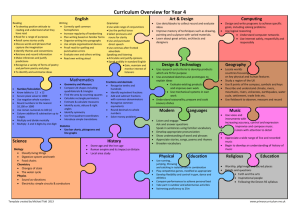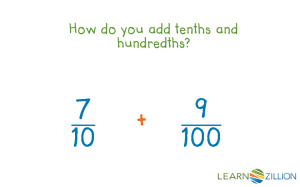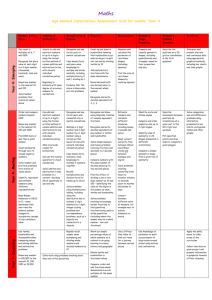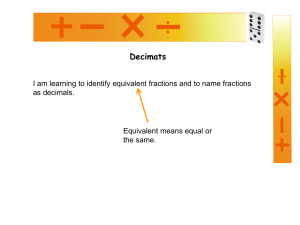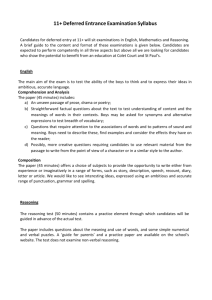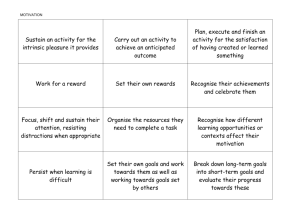W/B 2nd Sept W/B 7th Sept W/B 14th Sept W/B 21st Sept W/B 28th
advertisement
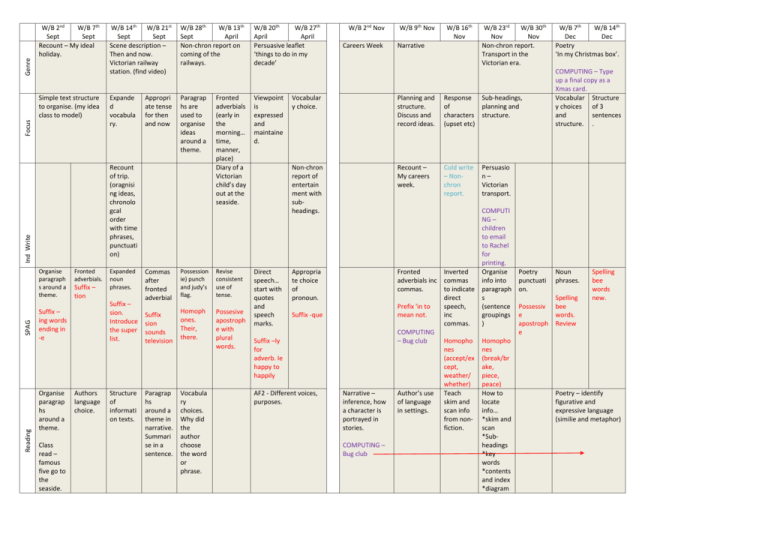
Genre W/B 2nd W/B 7th Sept Sept Recount – My ideal holiday. Focus Simple text structure to organise. (my idea class to model) Ind Write SPAG W/B 28th W/B 13th Sept April Non-chron report on coming of the railways. Expande d vocabula ry. Paragrap hs are used to organise ideas around a theme. Appropri ate tense for then and now Recount of trip. (oragnisi ng ideas, chronolo gcal order with time phrases, punctuati on) Organise paragraph s around a theme. Reading W/B 14th W/B 21st Sept Sept Scene description – Then and now. Victorian railway station. (find video) Fronted adverbials. Suffix – tion Suffix – sion. Introduce the super list. Suffix – ing words ending in -e Organise paragrap hs around a theme. Class read – famous five go to the seaside. Expanded noun phrases. Authors language choice. Structure of informati on texts. Commas after fronted adverbial Suffix sion sounds television Paragrap hs around a theme in narrative. Summari se in a sentence. Possession ie) punch and judy’s flag. Homoph ones. Their, there. Vocabula ry choices. Why did the author choose the word or phrase. Fronted adverbials (early in the morning… time, manner, place) Diary of a Victorian child’s day out at the seaside. Revise consistent use of tense. Possesive apostroph e with plural words. W/B 20th W/B 27th April April Persuasive leaflet ‘things to do in my decade’ Viewpoint is expressed and maintaine d. Direct speech… start with quotes and speech marks. W/B 2nd Nov Careers Week W/B 9th Nov W/B 16th Nov Narrative W/B 23rd W/B 30th Nov Nov Non-chron report. Transport in the Victorian era. Vocabular y choice. Planning and structure. Discuss and record ideas. Response Sub-headings, of planning and characters structure. (upset etc) Non-chron report of entertain ment with subheadings. Recount – My careers week. Cold write – Nonchron report. Appropria te choice of pronoun. Fronted Inverted adverbials inc commas commas. to indicate direct Prefix 'in to speech, mean not. inc commas. COMPUTING – Bug club Homopho nes (accept/ex cept, weather/ whether) Author’s use Teach of language skim and in settings. scan info from nonfiction. Suffix -que Suffix –ly for adverb. Ie happy to happily AF2 - Different voices, purposes. Narrative – inference, how a character is portrayed in stories. COMPUTING – Bug club W/B 7th W/B 14th Dec Dec Poetry ‘In my Christmas box’. COMPUTING – Type up a final copy as a Xmas card. Vocabular Structure y choices of 3 and sentences structure. . Persuasio n– Victorian transport. COMPUTI NG – children to email to Rachel for printing. Organise info into paragraph s (sentence groupings ) Homopho nes (break/br ake, piece, peace) How to locate info… *skim and scan *Subheadings *key words *contents and index *diagram Poetry punctuati on. Possessiv e apostroph e Noun phrases. Spelling bee words. Review Spelling bee words new. Poetry – identify figurative and expressive language (similie and metaphor) SUMMS Count in multiples of 6, 7, 9, 25 and 1000 -Find 1000 more or less than a given number Count backwards through zero to include negative numbers Count up and down in hundredths; recognise that hundredths arise when dividing an object by a hundred and dividing tenths by ten Compare numbers with the same number of decimal places up to two decimal places Estimate and use inverse operations to check answers to a calculation Recall multiplication and division facts for multiplication tables up to 12 × 12 Recall multiplication and division facts for multiplication tables up to 12 × 12 - Recognise the Find the effect of dividing a one- or twodigit number by 10 and 100, identifying the value of the digits in the answer as ones, tenths and hundredths Solve number and practical problems that involve all of the above and with increasingly large positive numbers Interpret and present discrete and continuous data using appropriate graphical methods including bar charts and time graphs -Solve comparison, sum and difference problems using information presented in bar charts, pictograms, tables and other graphs. Add and subtract numbers with up to 4 digits using the formal written methods of columnar addition and subtraction where appropriate Solve addition and subtraction two-step problems in contexts, deciding which operations and methods to use and why. Compare and classify geometric shapes, including quadrilaterals and triangles, based on their properties and sizes -Identify acute and obtuse angles and compare and order angles up to two right angles by size Identify lines of symmetry in 2-D shapes presented in different orientations -Complete a simple symmetric figure with respect to a specific line of symmetry Theme Maths place value of each digit in a four-digit number (thousands, hundreds, tens, and ones) -Order and compare numbers beyond 1000 - Recognise and write decimal equivalents of any number of tenths or hundredths Round decimals with one decimal place to the nearest whole number -Count up and down in hundredths; recognise that hundredths arise when dividing an object by a hundred and dividing tenths by ten Including decimals Mental multiplication and division Propertie s of numbers -Convert between different units of measure (e.g. kilometre to metre; hour to minute) Estimate, compare and calculate different measures, including money in pounds and pence Solve simple measure and money problems involving fractions and decimals to two decimal places Describe positions on a 2D grid as coordinates in the first quadrant -Describe movements between positions as translations of a given unit to the left/right and up/down -Plot specified points and draw sides to complete a given polygon Read, write and convert time between analogue and digital 12 and 24hour clocks -Solve problems involving converting from hours to minutes; minutes to seconds; years to months; weeks to days -Measure and calculate the perimeter of a rectilinear figure (including squares) in cm and m -Find the area of rectilinear shapes by counting squares Recognise and show , using diagrams, families of common equivalent fractions Research Victorian transport and the effect on holidays. Use researched info to complete the travel brochure pages for each decade. Editing and finalising book. Book launch and sale. Perform poem on green screen technology. COMPUTING – Using green screen recording apps. To investigate how sound waves are affected in sound. Create an amplifier uaing knowledge of sound waves travel. Create earphones to block sound by investigating which materials best block the sound. Volume and pitch of sounds. Changing state - making Christmas fayre products. To understand the pro and cons of emailing and how to attach files. Change font on Microsoft word (inc size, font, italic and colour) Save work in a sensible location. Use copy and paste to edit in Microsoft word. Insert border in Microsoft word. Record on ipads and use green screen technology apps. COMPUTING Solve problems involving increasingly harder fractions to calculate quantities, and fractions to divide quantities, including non-unit fractions where the answer is a whole number -Add and subtract fractions with the same denominator Science Complete fact sheets and glossary pages. Computing To understand how to carry out an effective internet search.


